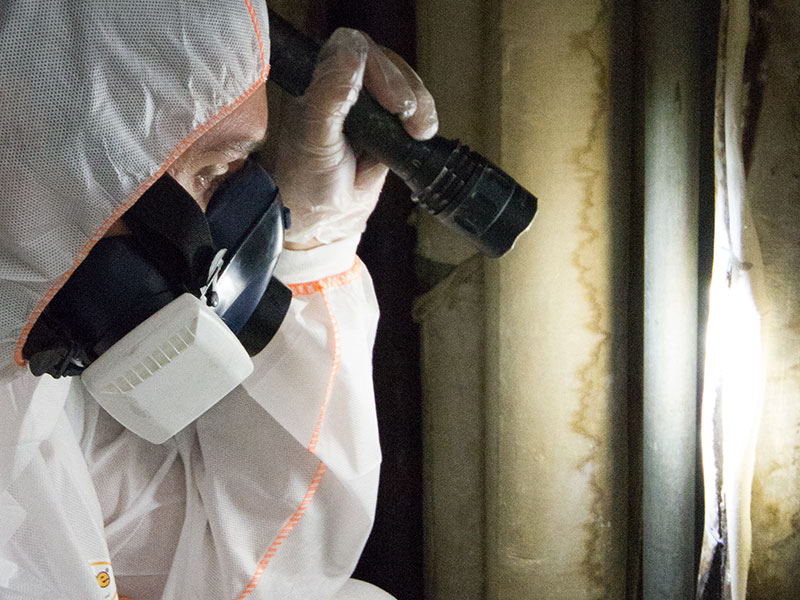Why is asbestos awareness crucial for contractors and homeowners during retrofits?
Asbestos was banned in the UK in 1999 once its life-threatening health effects were broadly understood. Before that, it was a common practice to use asbestos in various building materials.
Today, many older buildings in the UK still contain asbestos. What’s especially concerning is that those asbestos-containing materials (ACMs) are nearly 25 years old now. They may be breaking down due to time and age. They also could have been damaged at some point without the homeowner or building manager realising it.
Asbestos is dangerous when disturbed or damaged because toxic fibres become airborne. Once in the air, it’s easy for someone to swallow or inhale them without knowing it.
What is asbestos? Where is it commonly found in homes?
There are several types of asbestos, and many of them were common for commercial use, meaning they may be found in different parts of the home.
Amosite
Also called “brown asbestos,” amosite is one of the most common types used, and exposure to it has a high cancer risk. Common ACMs with brown asbestos include:
- Cement sheets
- Electrical insulation
- Gaskets
- Insulating blankets
- Pipes
- Roofing products
- Vinyl tiles
Chrysotile
Chrysotile is also known as “white asbestos,” and it’s even more common than brown asbestos. This type of asbestos can be found in materials like:
- Adhesives
- Cement
- Drywall
- Gaskets
- Insulation
- Roofing
- Textiles
- Vinyl tiles
Other types of commercial asbestos
Even though they were less common for commercial use, actinolite, crocidolite (blue), and tremolite asbestos may also be in ACMs, including ceilings, drywall, insulation, paint and plaster.
Why is asbestos awareness important for contractors during retrofits?
Asbestos awareness and advanced asbestos training are important for contractors. Being prepared is the only way to ensure everyone’s safety.
Health risks associated with asbestos exposure
While there aren’t any short-term effects of asbestos exposure, there are a number of serious long-term effects:
- Asbestosis
- COPD
- Lung collapse
- Mesothelioma
- Pleural effusion, plaques or thickening
- Various types of cancer
It’s also important to understand that while there aren’t short-term symptoms of asbestos exposure, short-term exposure can still pose a serious health risk. In other words, even a handful of interactions with asbestos fibres can potentially lead to health problems in the future.
A good example of this is 9/11. The damage to the World Trade Centre released a large number of asbestos fibres into the air. Even though some people had only short-term exposure to asbestos, many of them developed related diseases.
Legal responsibilities and regulations in the UK
The Control of Asbestos Regulations 2012 covers legal duties for complying with asbestos law in the UK. The Health and Safety Executive explains the regulations in practical, easy-to-understand ways for both the layman and asbestos experts.
One of the most important parts of CAR 2012 is the duty to manage asbestos in commercial buildings and common areas of domestic residences (like apartment buildings). The person in charge of basic maintenance for a commercial building is legally obligated to manage asbestos on the property.
What types of asbestos awareness training do contractors need?
Contractors who may be working with or around asbestos need proper training. This is the only way to keep everyone on the property safe.
Levels of asbestos awareness training
There are three main levels of asbestos training:
Asbestos Awareness (Category A)
This is the most fundamental type of asbestos training. It’s best for people who will not be working with asbestos but who may be around ACMs at work. That may include:
- Carpenters
- Decorators
- Electricians
- HVAC engineers
- Painters
- Plumbers
- Roofers
The goal of this training is to teach people to avoid disturbing ACMs. If the contractor has a job in a building with undamaged ACMs, they may only need this level of training to be fit for the job.
Non-Licensed Asbestos Work (Category B)
This level of training is required when performing non-licensed asbestos work. That may be regular non-licensed work or notifiable non-licensed work (NNLW), which means the appropriate authorities have to be informed of the project.
The training prepares contractors to safely work with or around asbestos, and topics typically include:
- Best practices
- Control measures
- Emergency procedures
- Personal protective equipment
- Risk assessments
- Waste removal
Compared to asbestos awareness training, Category B provides more information, instruction and training. It’s specifically for those who will be working on lower-risk asbestos jobs but need more information than general awareness can offer.
Licensed Asbestos Work (Category C)
High-risk asbestos work often requires a license. For example, these activities have a particularly high risk of exposure:
- Cleaning up fine asbestos debris
- Removing spray coating
- Work with insulating boards or loose-fill insulation
In order to be licensed, the contractor needs Category C training, along with additional practical training for the work ahead.
Certification requirements and accreditation bodies
The UK Asbestos Training Association is a leader in its field. When searching for an asbestos trainer, look for one that’s UKATA-approved.
Here’s what each type of asbestos training requires:
- Category A: This is a half-day course that lasts approximately 4-5 hours. It should be refreshed every 12 months.
- Category B: This full-day course lasts for around 6-7 hours. It must be updated every 12 months, at least.
- Category C: The course can take up to 3 days to complete, and the training is valid for one year.
Learn more about the asbestos training courses we offer here.
How does asbestos awareness training benefit contractors?
Asbestos training offers a lot of benefits to contractors, including the following:
- Contractors will be able to identify ACMs and potential ACMs.
- Workers will know the best practices to follow to avoid disturbing ACMs.
- They’ll know when it’s necessary to call a licensed asbestos professional instead of trying to handle a high-risk asbestos job on their own.
- Everyone on the property will stay safe from accidental asbestos exposure.
Even if you’re not working with high-risk ACMs, the right amount of training is imperative to protect everyone on the site.
What are the limitations of different types of asbestos awareness training?
While overall, asbestos training is a necessary part of working with or near ACMs, there are drawbacks to each category of training. Let’s go over them.
Asbestos Awareness (Category A)
Category A training is the most basic and general option available. It’s mainly for identifying ACMs and understanding their risk levels so they can be avoided.
Otherwise, it doesn’t offer any information about handling or removing ACMs. Since it’s missing a lot of information that some workers need, it doesn’t provide adequate training for many contractors.
Non-Licensed Asbestos Work (Category B)
This level of asbestos training is best for minor and non-invasive asbestos work. However, because it only provides broad guidance, contractors may need additional training. For example, workers who know about specific tasks that are coming up may need to take more courses to be prepared for the job ahead.
Licensed Asbestos Work (Category C)
This is the most extensive type of asbestos training available. It’s intended for people who will be working on high-risk asbestos projects.
The main drawback of Category C training is that regular refresher courses are necessary. Plus, while it’s not directly related to the training, this type of asbestos work means that the contractor will need regular medical checkups to prevent health problems.
How can contractors ensure compliance and safety during retrofits?
The most important part of an asbestos project is keeping everyone safe. This also means staying compliant with CAR 2012, which avoids fees and other penalties.
Pre-refurbishment asbestos surveys
Before a refurbishment project can occur, an asbestos survey must be carried out. There are two types of asbestos surveys:
- Management Survey: This tells the homeowner where ACMs are located, along with their condition. It’s for the purpose of monitoring ACMs, not preparing for a renovation project.
- Refurbishment and Demolition Survey: This is the type of asbestos survey you’ll want before you refurbish your home. It’s a more invasive type of survey that locates any ACMs that could be damaged during the home project.
To learn how to select a competent asbestos surveyor, check out this article.
Implementing an asbestos management plan
An asbestos management plan includes the asbestos register (which documents where ACMs are and their condition), along with procedures for managing asbestos on the property. Every plan should have the following:
- Information about the person responsible for managing asbestos on the property
- The asbestos register
- The schedule for monitoring the property’s ACMs
- Control arrangements and emergency procedures
The asbestos management plan should be accessible to anyone who could need it. It should also be easy to understand by all parties, including non-experts. Find out how to write an asbestos management plan here.
Final thoughts
Before a retrofit project can take place, it’s crucial to find all of the ACMs that could be damaged during the work. Encapsulation or removal is often necessary to keep everyone safe — asbestos contractors, those who live in the home, and even visitors. Ongoing education and attention to asbestos management are critical for protecting everyone’s health.

Written by Callum McDonald
Callum McDonald is an expert in asbestos quality management, ensuring rigorous adherence to regulations and high-quality standards in removal projects. His focus on enhancing quality and client satisfaction makes him a crucial asset in safety and compliance within the field. Callum's expertise in technical support and oversight of licensed works underscores his commitment to excellence in asbestos management, providing invaluable guidance to clients in this specialised area.

